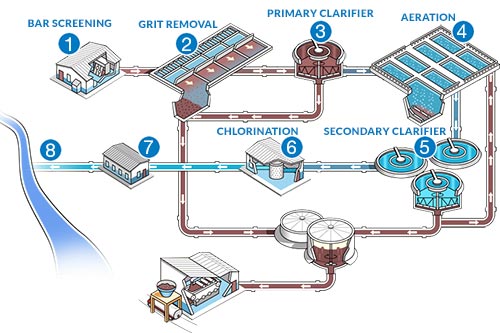Revolutionizing Wastewater Treatment with Eco-Friendly Innovations
Revolutionizing Wastewater Treatment with Eco-Friendly Innovations
Blog Article
Understanding Wastewater Treatment Processes and Their Ecological Impact
The complexities of wastewater therapy processes play a crucial duty in mitigating environmental difficulties related to water contamination. Each stage, from initial to advanced treatments, is designed to resolve certain impurities, eventually securing both public wellness and water ecosystems. However, regardless of technological developments in treatment performance, considerable obstacles persist, consisting of the administration of recurring contaminants and the ramifications of nutrient runoff. As we discover the intricacies of these procedures, it ends up being important to question just how much present techniques can progress to fulfill the expanding demands of sustainability and ecological preservation.
Overview of Wastewater Treatment
How is wastewater changed into a safe resource for the setting? Wastewater treatment is a crucial procedure created to remove impurities from used water, consequently safeguarding public health and securing ecological communities. This process begins with the collection of wastewater from residential, commercial, and business resources, which is then guided to treatment centers.
At these facilities, different physical, chemical, and organic methods are used to deal with the wastewater. Ultimately, organic treatments, such as turned on sludge procedures, utilize microorganisms to break down natural matter.
The dealt with effluent can be safely released right into natural water bodies or reused for watering and commercial functions, advertising resource preservation. Additionally, the treatment procedure produces biosolids, which can be repurposed as plant foods or soil amendments, further enhancing sustainability.
Stages of Treatment Processes
The wastewater treatment process usually includes three key phases: initial, key, and second therapy. Each stage serves a distinctive role in lowering the pollutant lots and guaranteeing the effluent fulfills ecological criteria prior to discharge.

The main therapy phase focuses on the physical separation of suspended solids from the wastewater. With sedimentation, larger fragments clear up at the base of sedimentation tanks, forming sludge, while lighter products, such as oils and oils, float to the surface area and are skimmed off. This procedure dramatically minimizes the organic and not natural lots in the wastewater.
Second treatment is a biological process intended at additional lowering the focus of organic matter. Different methods, consisting of triggered sludge systems and trickling filters, make use of microbes to metabolize organic pollutants. This stage is crucial for achieving the necessary biochemical oxygen need (BODY) reduction, ultimately bring about cleaner effluent all set for discharge or additional treatment. Each phase is essential in guarding ecological and public health and wellness.

Advanced Therapy Technologies
Complying with the additional treatment processes, advanced therapy technologies play a vital duty in additional improving the high quality of treated wastewater. These innovations are created to eliminate residual contaminants that are not successfully eliminated during primary and second treatments, guaranteeing the effluent fulfills stringent regulatory requirements.
Among the commonly utilized advanced therapy address methods are membrane layer filtering, reverse osmosis, and advanced oxidation procedures. Membrane purification, including microfiltration and ultrafiltration, is reliable in separating fine particles, microorganisms, and colloids from the water (Wastewater). Reverse osmosis makes use of semi-permeable membranes to get rid of liquified solids, leading to top notch water appropriate for various applications
Advanced oxidation processes (AOPs) employ solid oxidants to break down natural toxins, consisting of pharmaceuticals and individual care products that are resistant to conventional therapy. These methods boost the biodegradability of complicated substances, facilitating their removal.
Another considerable technology is the use of organic nutrient elimination processes, which especially target nitrogen and phosphorus, preventing eutrophication in receiving water bodies. Generally, innovative therapy innovations are necessary for attaining greater degrees of filtration, advertising water reuse, and guarding public wellness while addressing the obstacles associated with he has a good point wastewater management.
Ecological Advantages of Therapy
Many ecological benefits develop from efficient wastewater treatment processes that add to ecosystem wellness and sustainability. Largely, these procedures significantly lower the launch of unsafe toxins right into natural water bodies, which helps maintain marine ecological communities. By getting rid of impurities such as hefty metals, nutrients, and pathogens, dealt with wastewater alleviates the danger of waterborne diseases and promotes biodiversity in aquatic atmospheres.
Furthermore, wastewater treatment centers commonly utilize advanced technologies that make it possible for water recycling and reuse. This technique not just saves freshwater resources but also reduces the need on all-natural water products. Boosted nutrient elimination from wastewater can likewise avoid eutrophication, a process that leads to algal blooms and subsequent oxygen depletion in marine systems.
Furthermore, efficient treatment processes can minimize greenhouse gas emissions, particularly methane and laughing gas, which are usually released during neglected wastewater disintegration. By recording and using biogas from anaerobic digesters, centers can convert waste right into renewable resource, thereby adding to a decrease in nonrenewable fuel source dependence.
Challenges and Future Patterns
While the ecological benefits of wastewater treatment are clear, numerous challenges continue that prevent optimal results in this area. One major issue is maturing framework, which typically brings about inefficiencies and boosted functional prices - Wastewater. Numerous therapy plants were made decades ago, and their abilities do not straighten with modern demands, which include more stringent governing standards and higher volumes of wastewater because of urbanization

Looking ahead, there is a growing focus on source recovery and round economic situation concepts within wastewater treatment. Innovations such as anaerobic click here for more food digestion, which can create biogas, and advanced purification modern technologies are acquiring traction. These approaches not only boost therapy efficiency yet additionally promote sustainability.
Ultimately, addressing these obstacles needs collaboration amongst stakeholders, investment in modern technology, and a dedication to ongoing study. By accepting these trends, the wastewater therapy sector can progress to meet the needs of an altering setting and society.
Verdict
In verdict, wastewater therapy processes play an important function in boosting environmental quality and public health and wellness. The multi-stage therapy framework, combined with sophisticated innovations, effectively minimizes contamination and advertises lasting water administration.
Report this page